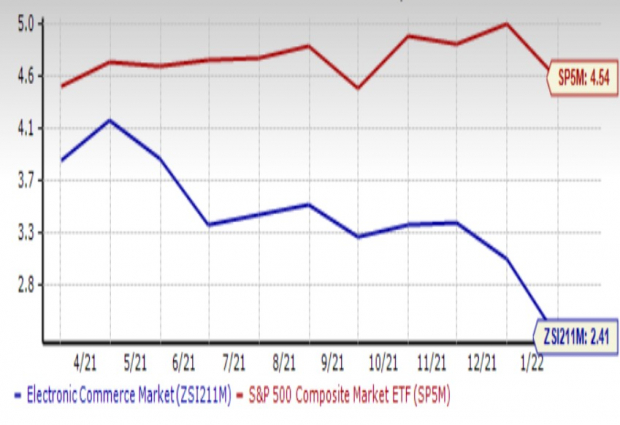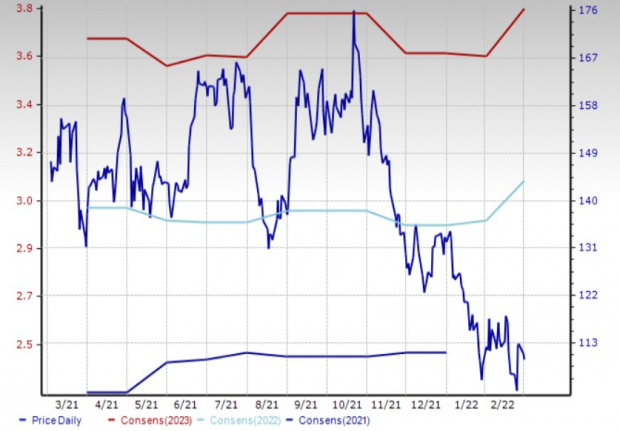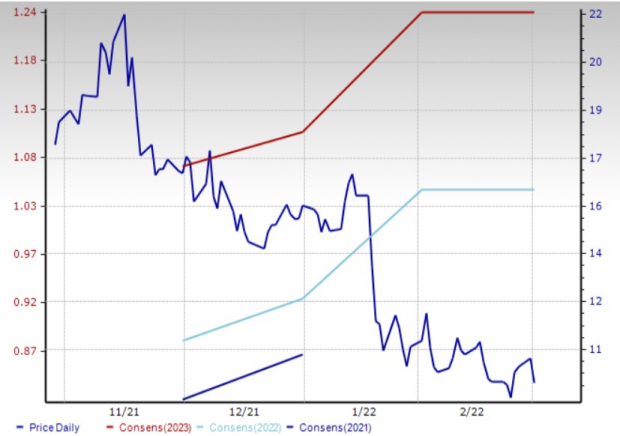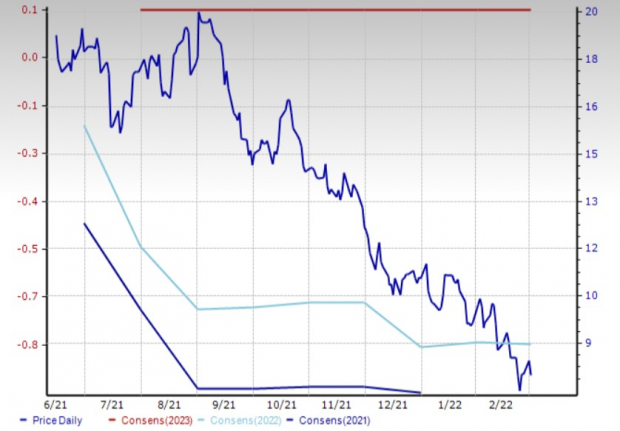Accordingly, ecommerce sales in the last quarter were 9.4% above 4Q20 (up 1.7% sequentially), with total retail sales increasing 15.2% (up 2.5% sequentially). Ecommerce accounted for around 12.9% of total U.S. retail sales, a slight deceleration from each of the four preceding quarters. As these estimates from the Commerce Department indicate, some of the traffic that moved online during the initial months of the pandemic is moving back to stores. So there are difficult comps.
Ecommerce continues to grow strongly off a smaller base growing its share of the total retail pie. And this is helped by the race to digitization, consumer habits altering for good and supply chains adjusting to help the two sides meet.
Valuation, although still elevated, is beginning to reflect the relatively weaker prospects. But there are a number of smaller players that still look attractive. We’ve picked MTCH, DTC and GRUB.
About The Industry
Internet - Commerce continues to evolve as the technologies driving it advance.
On the one side are increasingly powerful and capable user devices. On the other are sophisticated, AI-enabled software platforms facilitating transactions that are thereby, more capable of delivering user satisfaction. Social commerce and chatbots are further facilitating things.
Differentiation comes from better technology for improved showcasing, easier navigation and payment, speedier delivery and returns, brand building, comparison shopping, loyalty, etc. which generally tip the scales in favor of larger players. Particularly because there is fierce price competition necessitating deep discounting, which keeps prices down.
Amazon AMZN dominates, traditional players are rapidly digitizing and new players continue to emerge.
Factors Shaping the Future of the Internet-Commerce industry
- The pandemic has proved extremely beneficial for ecommerce players, and not just because of the government-mandated stay-home orders that led to soaring business volumes. While markets have reopened to a large extent, purchasing trends haven’t gone back to where they were before. Just like many companies temporarily adopting work-from-home practices are expected to make it a broader trend, many shoppers that preferred going to stores earlier have now had a taste of the convenience of online shopping. And as far as retailers are concerned, the importance of having a digital presence has never been clearer. One thing this trend should boost (if technology companies are up to it) is the adoption of AR/VR technology because of its potential to greatly enhance showcasing. The technology is already being leveraged very effectively in the housing market. Also, the ability to fit things like furniture or other items where people want it in their homes is better even than physical retail. More stores will likely be converted into delivery hubs to facilitate this trend.
- As American companies like Amazon and Walmart continue their march to conquer the world, it’s relevant for this outlook to include data that goes beyond the borders. Accordingly, global retail ecommerce grew around 16% in 2021. In 2022, most of the strength is expected to come from the Philippines, India, Indonesia and Brazil growing the fastest, by at least 22%. Total retail sales growth is expected to go from +9.7% in 2021 to +5.0% in 2022. Ecommerce will grow its share of total global retail sales from an estimated 21% this year to 24.5% by 2025. The top five ecommerce markets are China, U.S., UK, Japan and South Korea. Amazon’s share of U.S. ecommerce (expected to grow 16.1% this year by Insider Intelligence) is around 40%, and the leading retailer is expected to grow 15.3% this year. Traditional retailers’ focus on digital initiatives including click and collect, cashierless checkout, contactless payment and digital signage should continue, despite customers returning to stores. Online retailers’ focus remains on social commerce, grocery sales and the buy-now-pay-later option.
- Both ecommerce pureplays and traditional retailers and balancing ecommerce sales with a physical presence because it is only proximity to a consumer that can facilitate quick delivery. This is moving retailers toward a hybrid/omnichannel model that customers can get quick delivery from, or from where they can pick up the items ordered online (BOPIS, curbside pickup), at their convenience, through apps. Self-driven delivery vehicles and drones are already on the horizon to deal with logistics problems and make deliveries smoother and cheaper.
- Also, data mining has never been easier. Because of the many details involved in satisfying a customer, data mining has grown in importance over the years, with the party controlling the customer’s data being best positioned to identify and service demand while also delivering the desired experience. Most of the big ecommerce players are also into payments processing, which gives them further insight into a customer’s tastes, preferences and buying habits. As machines read and process this data, they can create programs and processes to maximize customer satisfaction and drive sales. Artificial intelligence such as that used by companies like Amazon already decides how competitive a player is. But as time goes by, more and more retailers are jumping on board and harnessing big data that has become imperative for survival.
- All said, companies moving online and existing players utilizing more advanced tools and analytics to increase their return on investment remain positives for the industry. At the same time, profitability could come in for some pressure (for some) as companies invest heavily in building out infrastructure to support the next leg of growth and and deal with continued supply chain issues.
Zacks Industry Rank Reflects Weak Near-Term Growth
The Zacks Internet - Commerce Industry is a rather large group within the broader Zacks Retail And Wholesale Sector. It carries a Zacks Industry Rank of #208, which places it in the bottom 16% of more than 250 Zacks industries.
Our research shows that the top 50% of the Zacks-ranked industries outperforms the bottom 50% by a factor of more than 2 to 1. So the group’s Zacks Industry Rank, which is basically the average of the Zacks Rank of all the member stocks, indicates weak near-term prospects.
The industry’s positioning in the bottom 50% of the Zacks-ranked industries is a result of its relative performance versus others. As far as aggregate estimate revisions are concerned, it appears that analysts expect earnings to decline this year by 60.8% and the next year by 61.8%. The decline is mostly because of difficult comps, as the industry comes off the extremely strong 2020 results, on top of the increased cost of operation and amortization and other charges related to infrastructure buildup.
Before we present a few stocks that you may want to consider for your portfolio, let’s take a look at the industry’s recent stock-market performance and valuation picture.
Industry Lags On Shareholder Returns
The Zacks Internet- Commerce Industry has traded at a discount to both the broader Zacks Retail and Wholesale Sector as well as the S&P 500 index over the past year. This is because of the changing sentiment, as physical stores open up, taking back some of the sales that moved online during the pandemic.
So we see that the stocks in this industry have collectively lost 47.0% of their value over the past year, compared to the broader Zacks Retail and Wholesale Sector, which lost 21.6% and the S&P 500, which gained 12.2%.
One-Year Price Performance

Image Source: Zacks Investment Research
Industry's Current Valuation
On the price-to-forward 12 months’ earnings (P/E) basis, the industry still looks grossly overvalued (37.35X) with respect to both the S&P 500 (19.49X) and the broader retail sector (23.38X).
On the basis of forward 12 months’ sales (P/S) however, the industry’s multiple of 2.41X trails the S&P 500’s 4.54X although it remains understandably higher than the sector’s 1.07X. Over the past year, the industry has traded as high as 4.20X, as low as 2.41X and at the median of 3.36X, as the chart below shows.
Forward 12 Month Price-to-Sales (P/S) Ratio

Image Source: Zacks Investment Research
3 Stocks Worth Considering
Match Group (MTCH): Dallas, Texas-based Match Group, Inc. provides dating products worldwide. The company's portfolio of brands includes Tinder, Match, Meetic, OkCupid, Hinge, Pairs, PlentyOfFish and OurTime, as well as various other brands.
Match Group has done extremely well during the pandemic because social distancing prevented people from meeting physically. But since vaccination and the reopening are likely to increase in-person meetings, the company is betting on virtual hangout spaces and community-wide live events such as Swipe Nights and quizzes to keep users interested and engaged.
And analysts remain extremely positive about its prospects both in 2022 and 2023. They currently expect Match Group’s revenue and earnings to grow a respective 18% and 125% in 2022. The strength is expected to continue the following year. The Zacks Rank #2 (Buy) company’s estimates are also moving up. The 2021 estimate is up 5.0% in the last 30 days while the 2023 estimate is up about 45%.
The shares are down 29.5% over the past year.
Price & Consensus: MTCH

Image Source: Zacks Investment Research
Solo Brands, Inc. (DTC): Texas-based Solo Brands started out as a digitally native platform selling stoves and fire pits under the Solo Stove brand. Last year, it acquired three more outdoor lifestyle brands (Oru, ISLE and Chubbies) that significantly expanded its product range. The Oru brand brought kayaks, the ISLE brand brought paddle boards and the Chubbies brand brought swim trunks, casual shorts, sport products, polos, shirts and lounge products. Thus, the company became Solo Brands and launched its IPO in 2021. While it has a global supply chain, its products are sold in the U.S. And given the nature of its products, it enjoys seasonal strength in the second and fourth quarters.
The pandemic has been both good and bad for Solo Brands. Bad because it necessitated social distancing, which made word-of-mouth referrals difficult. Since this is a primary driver of sales for the direct-to-consumer (DTC) platform, there was a certain negative impact. Word-of-mouth referrals for example had dropped to 26% of solostove.com orders in Mar 2020, but they recovered to 45% of orders in Mar 2021. Another negative was the supply chain, which increased freight and container shipping costs while also impacting product availability. But the pandemic was also positive because it increased consumer interest in outdoor living and outdoor recreation while also necessitating that they do their shopping online (which is how the company’s products are sold).
The combined impact is overwhelmingly positive for Solo Brands. As a result, the company raised its full-year 2021 outlook in January. Revenue guidance jumped from $348 million at the mid-point to $401 million. Pro-forma Revenue, assuming all brands were owned for the entirety of 2021, was preliminarily estimated to be approximately $482 million, up approximately 130% over the prior year.
The Zacks Consensus Estimate for the 2022 EPS is up 11.8% in the last 60 days. The Zacks Rank #2 (Buy) stock is down 44.6% since it started trading.
Price & Consensus: DTC

Image Source: Zacks Investment Research
Just Eat Takeaway.com N.V. (GRUB): Amsterdam, the Netherlands-based Just Eat operates an online food delivery marketplace, connecting consumers and restaurants through its platforms. It has operations across most European countries, Australia, New Zealand and the U.S. (through its Grub Hub acquisition last year). In 2021, it had 580,000 restaurants in its network that generated 1.1 billion orders (up 33% over the prior year).
Just Eat’s aggressive expansion drive has added a large number of restaurants to its network thus expanding restaurant selection for its customers. This is the main factor driving its orders. 2021 orders grew double-digits across geographies, but the greatest strength was in the UK and northern Europe (mainly Germany). Just Eat is seeing continued strength in delivery orders despite restaurants opening up again.
The increasing level of regulatory scrutiny is a bit of a concern. In the U.S., some state regulators are looking to cap the fees that delivery companies can charge restaurants, mandating the sharing of customer details like names, phone numbers, mailing addresses and purchase histories when requested by restaurants and requiring delivery companies to break down their charges for consumers. The EU Commission's proposals to improve conditions for workers and help them access social protections is also a potential headwind.
Profitability still seems far away but the fact that the company is meeting its own targets is encouraging.
The aggressive expansion is telling on this Zacks Rank #2 stock’s estimates, which therefore don’t look too encouraging at the moment.
The shares are down 59.6% since Jun 2021.
Price & Consensus: GRUB

Image Source: Zacks Investment Research
Bitcoin, Like the Internet Itself, Could Change Everything
Blockchain and cryptocurrency has sparked one of the most exciting discussion topics of a generation. Some call it the “Internet of Money” and predict it could change the way money works forever. If true, it could do to banks what Netflix did to Blockbuster and Amazon did to Sears. Experts agree we’re still in the early stages of this technology, and as it grows, it will create several investing opportunities.
Zacks’ has just revealed 3 companies that can help investors capitalize on the explosive profit potential of Bitcoin and the other cryptocurrencies with significantly less volatility than buying them directly.
See 3 crypto-related stocks now >>Want the latest recommendations from Zacks Investment Research? Today, you can download 7 Best Stocks for the Next 30 Days. Click to get this free report
Amazon.com, Inc. (AMZN): Free Stock Analysis Report
Just Eat Takeaway.com N.V. Sponsored ADR (GRUB): Free Stock Analysis Report
Match Group Inc. (MTCH): Free Stock Analysis Report
Solo Brands, Inc. (DTC): Free Stock Analysis Report
To read this article on Zacks.com click here.
Zacks Investment Research
The views and opinions expressed herein are the views and opinions of the author and do not necessarily reflect those of Nasdaq, Inc.


